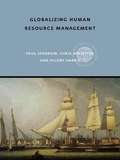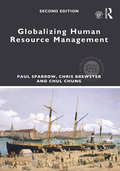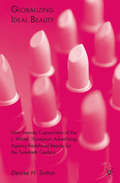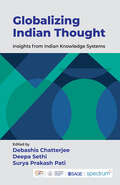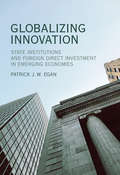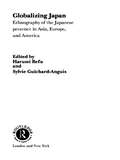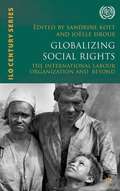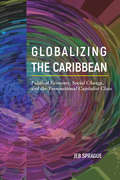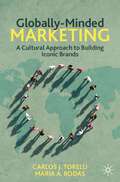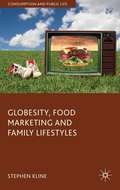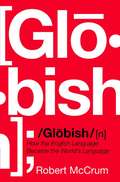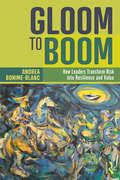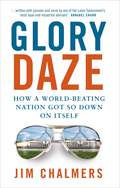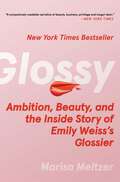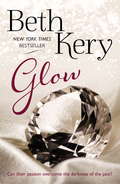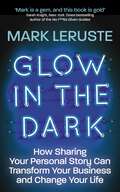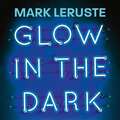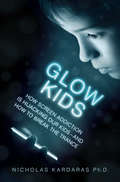- Table View
- List View
Globalizing Human Resource Management
by Paul Sparrow Chris Brewster Hilary HarrisEstablishing the agenda for global HR, this book looks through the eyes of HR professionals themselves. It gives a broad, coherent overview of the field of IHRM and a detailed, practical analysis of what is needed to be successful in this crucial area of modern management. A number of key questions are addressed: Does IHRM drive the business agenda more than domestic HRM? What is the impact of IHRM on organizational effectiveness? What are the keys to success in IHRM? Drawing upon current research conducted as part of the Chartered Institute of Personnel and Development's Globalization Research Project the text includes data from surveys of HR professionals and company practice as well as longitudinal case studies.
Globalizing Human Resource Management (Global HRM)
by Paul Sparrow Chris Brewster Chul ChungThis new edition of Globalizing Human Resource Management examines the strategic and global issues of HRM by showing how organizations address the tradeoffs between global integration and local responsiveness. Sparrow, Brewster, and Chung discuss varying methods of globalized talent management and employer branding and conclude with a multi-dimensional approach to HRM. The second edition includes: Updated analyses of talent management, employer branding, and outsourcing of HRM Broader geographic focus, including a new focus on Asian firms and other emerging markets Exploration of the impact of strategic management thinking on HR as well as the latest research in other areas, such as operations, marketing, and economic geography Complementing traditional international HRM texts, this is an ideal book for any student interested in the actual strategic logics being pursued by the HR function today.
Globalizing Ideal Beauty
by Denise H. SuttonGlobalizing Ideal Beauty is the forgotten history of a group of women copywriters whose successful ad campaigns went international in the 1920s and spread an American notion of feminine appeal from Bangor to Bangkok. Sutton's approach is grounded in a huge body of original archival research that has so far remained largely untapped.
Globalizing Indian Thought: Insights from Indian Knowledge Systems
by Debashis Chatterjee Deepa Sethi Surya Prakash PatiThe overarching principle that once integrated India’s institutions is often described by the word ‘dharma’. The notion of dharma goes well beyond what is known as ‘rule of law’. Rule of law is about publicly disclosed legal codes and processes. Dharma, on the other hand, is the holding principle that encompasses the whole of nature, including human nature. Dharma is much more nuanced and yet, paradoxically, more unambiguous than rule of law. The research presented in Globalizing Indian Thought tells us that India will do well to hark back to its ‘sanatana dharma’. The book decodes and deliberates on a few big ideas with the hope to shape India’s story on the world stage. It would be of interest to anyone who wishes to know how we can bring in ideas that are inherently Indian to broaden the discourse on matters of national and international importance.
Globalizing Innovation: State Institutions and Foreign Direct Investment in Emerging Economies (The\mit Press Ser.)
by Patrick J.W. EganThe impact of host country institutions and policy on innovation by multinational firms in emerging economies.In the past, multinational firms have looked to developing countries as sources of raw materials, markets, or production efficiencies, but rarely as locations for innovation. Today, however, R&D facilities and other indicators of multinational-linked innovation are becoming more common in emerging economies. In this book, Patrick Egan investigates patterns of inward foreign direct investment (FDI) in developing countries, considering the impact of host country institutions and policy on the innovative activities undertaken by multinational firms. He examines the uneven spread of innovation-intensive foreign direct investment and emerging sectoral distributions, then develops a number of arguments about the determinants of multinational innovation in developing countries. Firms are attracted by a country's supply of skilled labor and are often eager to innovate close to new markets; but, Egan finds, host country institutions and the configuration of the host country's investment policies have a strong impact on firm decisions and evolving country investment profiles.Egan uses econometric analysis to identify determinants of multinational innovation, and examines differences among state institutions as a key variable. He then offers a detailed case study, assessing Ireland's attempts to use foreign direct investment in innovation as a catalyst for development. While FDI is a potential vehicle for industrial upgrading, Egan cautions, it is neither necessary nor sufficient for development. Furthermore, innovation-intensive investments are not likely to develop linkages with local actors or otherwise embed themselves in host economies in the absence of active, discriminating policies channeled through coherent and coordinated institutions.
Globalizing Japan's Dream Machine: Recruit Holdings Co., Ltd.
by Sandra J. Sucher Shalene GuptaGlobalizing Japan's Dream Machine: Recruit Holdings Co., Ltd. by Sandra J. Sucher, Shalene Gupta
Globalizing Japan: Ethnography of the Japanese presence in Asia, Europe, and America (Nissan Institute/Routledge Japanese Studies)
by Harumi Befu Sylvie Guichard-AnguisGlobalizing Japan explores the social and cultural dimensions of Japan's global presence. Japan's expansion and presence as an economic giant is witnessed on an everyday basis. Both consciously and unconsciously, we regularly come into contact with Japan's industrial and cultural globalization, from cameras and automobiles to judo, cuisine or animation. Japan's presence in the popular imagination is heavily influenced both by the country's historical past and its global present. This book will appeal to students and scholars of Japanese Studies, Anthropology and Cultural Studies.
Globalizing Rural Development
by M C BeheraEver since rural development emerged as an independent field of inquiry in the 1950s, it has been subjected to many changes in emphasis and ideology. These changing perspectives have resulted in shifts in policies and programmes and have influenced the international discourse on rural development. The recently initiated process of globalisation has brought in its wake yet more rethinking on the most appropriate approach to rural development. Conceived against this background, this volume examines the impact of the changing paradigm of rural development on poverty alleviation, equity, gender, food security, employment and sustainability. The volume's major concern is: Can the goals of rural development be achieved in a globalised world? The central argument is that the new paradigm of rural development reflects the core-periphery dichotomy, in which the core imposes on the periphery--in a top down approach--in all major interventions. As a result, maintain the contributors, the new paradigm is ridden with limitations in addressing the highly differentiated needs and contexts of rural development both in developing and developed countries. Divided into four sections including the introduction, the volume -examines the inherently contradictory relationship between the new development paradigm and the goals of rural development; -studies the new role of the state and state-led interventions in the context of globalisation, and the role and potential of NGOs in rural development; - highlights the rural livelihood framework and the impact of endogenous efforts at rural development in various European and Asian countries; and, -presents participatory methods for addressing problems like food security, women's empowerment, and poverty alleviation.
Globalizing Social Rights
by Sandrine Kott Joëlle DrouxBased on the case of the ILO, both as an actor and driver of international social policy, this collection explores the internationalization process of social rights, in a number of national and international contexts. This collection brings together a variety of new scholarship by a group of highly qualified and internationally renowned scholars.
Globalizing the Caribbean: Political Economy, Social Change, and the Transnational Capitalist Class
by Jeb SpragueThe beautiful Caribbean basin is fertile ground for a study of capitalism past and present. Transnational corporations move money and labor around the region, as national regulations are reworked to promote conditions benefiting private capital. Globalizing the Caribbean offers a probing account of the region’s experience of economic globalization while considering gendered and racialized social relations and the frequent exploitation of workers. Jeb Sprague focuses on the social and material nature of this new era in the history of world capitalism. He combines an historical overview of capitalism in the region with theoretical analysis backed by case studies. Sprague elaborates upon the role of class formation and the restructuring of local states. He considers both U.S. hegemony, and how various upsurges from below and crises occur. He examines the globalization of the cruise ship and mining businesses, looks at the growth of migrant labor and reverse flow of remittances, and describes the evolving role of export processing and supranational associations. In doing so, Sprague shows how transnationally oriented elites have come to rule the Caribbean, and how capitalist globalization in the region occurs alongside shifting political, institutional, and organizational dynamics.
Globalizing the Cost of Capital and Capital Budgeting at AES
by Mihir A. Desai Doug SchillingerWith electricity generating businesses around the world, AES Corp. is seeking a methodology for calculating the cost of capital for its various businesses and potential projects. In the past, AES used the same cost of capital for all of its capital budgeting, but the company's international expansion has raised questions about this approach and whether a single cost of capital adequately accounts for the different risks AES faces in its diverse businesses and diverse environments. The company recently suffered heavy losses from currency devaluations in South America and regulatory changes in other countries. The director of the corporate planning group is developing a methodology for taking account of different country and project risks, and the case allows students to use this methodology to calculate the cost of capital for 15 different projects around the world. Students must consider how a global firm can account for differing risks in evaluating its international operations and in investing abroad. To obtain executable spreadsheets (courseware), please contact our customer service department at custserv@hbsp.harvard.edu.
Globally-Minded Marketing: A Cultural Approach to Building Iconic Brands
by Carlos J. Torelli Maria A. RodasThis textbook shows students how to conduct strategic marketing with a global mindset, rather than just with an international focus. It illustrates how companies can take advantage of the opportunities and address the challenges associated with the increasing globalization of markets. Readers will learn about how culture shapes consumer needs and preferences, the impact of foreign political and economic factors on companies, the influence of international competition, and how to segment markets based on cultural factors. Drawing from novel theoretical insights in social psychology, cultural psychology, marketing, and management, the book provides a broad theoretical foundation for understanding the impact of culture on both global and ethnic branding decisions, and particularly so for devising branding strategies aimed at creating iconic brands that can resonate with today’s consumers, who tend to be more multicultural.
Globesity, Food Marketing and Family Lifestyles
by Stephen KlineThis book examines the public controversies surrounding lifestyle risks in the consumer society. Comparing news coverage of the 'globesity' pandemic in Britain and the USA, it illustrates the way moral panic brought children's food marketing to the centre of the policy debates about consumer lifestyles.
Globish: How the English Language Became the World's Language
by Robert MccrumIn this provocative and compelling new work, the co-author of the bestselling book and television series "The Story of English" shows how English became the language of the world.
Gloom to Boom: How Leaders Transform Risk into Resilience and Value
by Andrea Bonime-BlancLeaders – whether in business, government or the nonprofit sector – take risks but often without fully understanding risk at a strategic level. Expanding upon the well-known "ESG" risks, this book explains the key nonfinancial (environmental, social, governance and technological or ESGT) risks. For many leaders (including board members), taking risk without knowledge or preparation can lead to organizational crisis, scandal and value destruction. For those who are prepared, resilience follows and so does the ability to transform ESGT risk into opportunity and value for stakeholders. In this book, global governance, risk, ethics and cyber strategist, author and board member, Andrea Bonime-Blanc, shows practitioners at all levels how to effectively identify and manage their top ESGT risks to avoid crises and transform risk into sustainable long-term resilience and value. Gloom to Boom is a book for everyone – from the highest levels of leadership in an organization (the board, CEO and C-suite), to other senior leaders (the chief risk officer, CFO, general counsel, head of CSR and sustainability, CISO, CHRO), and midlevel leaders, students and folks simply interested in current affairs and the role and impact of strategic risk and opportunity on their lives.
Glory Daze: How a world-beating nation got so down on itself
by Jim ChalmersWhy does Australia, a nation with one of the world's best economies, have such a dim view of its own performance? Why does it see itself as worse off than some of the basket-case economies of southern Europe? How did a country that was smart enough to avoid recession and mass unemployment despite a global meltdown get so down on itself? In Glory Daze Jim Chalmers argues that the combination of hyper-partisanship and self-serving incentives in politics have resulted in a deficit of national self-esteem. This insider account provides a unique perspective on national identity. Chalmers concludes that unless a stop is put to the poisonous politics of recent years, Australia runs the risk of squandering existing national advantages and compromising our ability to tackle the challenges of the future.
Glossary of TOM Terms
by W. Bruce ChewProvides definitions of technology and operations management terms.
Glossier: Co-Creating a Cult Brand with a Digital Community
by Jill AveryGlossier's proclaimed strategy was "born from content, fueled by community". The digital-first, direct-to-consumer beauty brand had experienced rapid growth, with sales up 600% in 2017 and a customer portfolio that grew by threefold. But, its founder, Emily Weiss, was not complacent. Instead, she dreamed of creating the world's first socially-driven brand that inserted its community into the buying experience so that the company was merchandising people, their opinions, and their content, just as much as they were merchandising products. As her team debates marketing strategies for 2018, they recognize the opportunities and challenges associated with managing Glossier's rapidly scaling brand community. While the community's support had emerged organically in the past, the team was now debating whether the company's next phase of growth would need to be fueled by a greater emphasis on paid peer-to-peer sales representatives, professional influencer marketing, paid media, and a physical market presence.
Glossy: Ambition, Beauty, and the Inside Story of Emily Weiss's Glossier
by Marisa MeltzerINSTANT NEW YORK TIMES BESTSELLER • Financial Times Best Book of the Year The &“compulsively readable narrative of beauty, business, privilege, and mogul-dom&” (The New York Times) that reveals—for the first time—exactly wat happened at Glossier, one of America&’s hottest and most consequential startups, and dives deep into the enigmatic, visionary woman responsible for it all.Called &“one of the most disruptive brands in beauty&” by Forbes, Glossier revolutionized the beauty industry with its sophisticated branding and unique approach to influencer marketing, almost instantly making the company a juggernaut with rabid fans. It also taught a generation of business leaders how to talk to Millennial and Gen Z customers and build a cult following online. At the center of the story lies Emily Weiss, the elusive former Teen Vogue &“superintern&” on the reality show The Hills turned Into the Gloss beauty blogger who had the vision, guts, and searing ambition needed to launch Glossier. She cannily turned every experience, every meeting into an opportunity to fuel her own personal success. Together with her expensive, signature style and singular vision for the future of consumerism, she could not be stopped. Just how did a girl from suburban Connecticut with no real job experience work her way into the bathrooms and boudoirs of the most influential names in the world and build that access into a 1.9-billion-dollar business? Is she solely responsible for its success? And why, eight years later, at the height of Glossier mania, did she step down? In Glossy, journalist and author Marisa Meltzer combines in-depth interviews with former Glossier employees, investors, and Weiss herself to bring you inside the walls of this fascinating and secretive company. From fundraising to product launches and unconventional hiring practices, Meltzer exposes the inner workings of Glossier&’s culture, culminating in the story of Weiss herself. The Devil Wears Prada for the Bad Blood generation, Glossy is not just a gripping portrait of one of the most important business leaders of her generation, but also a chronicle of an era.
Glovo: Expanding Quick Commerce
by James Barnett Antonio MorenoIn March 2021, delivery app CEO Oscar Pierre and his team consider strategies to grow Glovo's quick commerce delivery service and to approach their expansion in Kenya.
Glow (Glimmer and Glow Series)
by Beth KeryFor fans of E. L. James, Sylvia Day, Jodi Ellen Malpas, J. Kenner and Maya Banks. The New York Times bestselling author of the Because You Are Mine series and The Affair, returns to Alice and Dylan's heartstopping love affair in the sequel to Glimmer...Alice Reed never dreamed she'd escape the stigma of her past. Stunned to be handpicked by the CEO of Durand Enterprises, she was even more shocked to discover that Dylan Fall desired her for pleasure, as well as business... But their deliciously forbidden time together is shattered by a startling secret. The shadows of Alice's past are brutally surfacing, her true identity being revealed. It soon becomes clear that she's battling a mysterious enemy, intent on destroying her. Dylan will do anything to protect Alice. But as Alice falls helplessly in love, she's forced to question how deeply she can trust him. What secrets of her past is he hiding? And can their future survive the truth?Alice and Dylan's passionate, explosive romance began in Glimmer.For more electrifying romance, don't miss the other captivating titles by Beth Kery, The Affair, the One Night of Passion series, and her bestselling erotically charged series which began with Because You Are Mine.
Glow In The Dark: How Sharing Your Personal Story Can Transform Your Business and Change Your Life
by Mark LerusteMost people are afraid of what others might think or say if they showed up as their true authentic selves. Especially in a business or professional context. That's why too many of us are terrified of sharing our story authentically in public and struggle to make a lasting impact when introducing ourselves.But what if you could make a connection instantly, effortlessly engaging your audience every time you introduced yourself and the work that you do, be it on stage, at work or on a podcast? And more importantly, what if you could get people to care about and pay attention to what you had to say, share or sell? Turns out, learning how to find the courage to craft and communicate your story in a clear and compelling way can help you do just that.CEO and Founder of Ministry of Purpose©, public speaker and award-winning host of The Unconventionalists© podcast Mark Leruste (@markleruste) has found a simple 3-step structure that anyone can follow to turn your myriad of life experiences into a memorable and magnetic origin story people will remember and share with others on your behalf.From helping you land bigger media opportunities, generate more leads for your business or attract top talent, Glow in the Dark is a refreshingly practical and thought provoking book on why everyone has a powerful story worth telling, and how owning and sharing your story can have a transformative impact on your life and business beyond your wildest imagination. The methods in this book will get you out of the shadows and help you raise your profile by becoming the spotlight in your industry."With wit, warmth, and the benefit of his own considerable experience and success, Mark will convince you why your personal story is important, and show you how to tell it. He is a gem, and this book is gold." - Sarah Knight, New York Times bestselling author of the No F**ks Given Guides
Glow In The Dark: How Sharing Your Personal Story Can Transform Your Business and Change Your Life
by Mark LerusteShare your authentic self. shine a light on your best work and learn to glow in the dark.When you talk about yourself and the work you do, what message do you convey? Do you tell your best story and show your most authentic self, or do you undersell your talents and fail to sell your strengths? Too many of us feel like imposters, playing down our achievements, failing to do our brilliant ideas justice. Many of us are simply too afraid of what people might think or say if we showed up as our authentic selves in public and shared our true stories. Countless brilliant ideas will never see the light of day because people are too timid to truly be themselves. It doesn't have to be this way. This audiobook will help you get comfortable with being yourself in public, accept who you are, and celebrate every part of you and your story - even the scary bits.No matter where you are on life's journey, no matter what your experience or background, you can learn a simple framework to turn your myriad of experiences into a powerful, engaging, and clear origin story that people will connect with, remember, and want to share with others on your behalf.From hiding your talents to glowing in the dark, this audiobook will help you tell your story with confidence.(P) 2022 Hodder & Stoughton Limited
Glow Kids: How Screen Addiction Is Hijacking Our Kids - and How to Break the Trance
by Nicholas KardarasWe've all seen them: kids hypnotically staring at glowing screens in restaurants, in playgrounds and in friends' houses--and the numbers are growing. Like a virtual scourge, the illuminated glowing faces--the Glow Kids--are multiplying. But at what cost? Is this just a harmless indulgence or fad like some sort of digital hula-hoop? Some say that glowing screens might even be good for kids--a form of interactive educational tool. Don't believe it. In Glow Kids, Dr. Nicholas Kardaras will examine how technology--more specifically, age-inappropriate screen tech, with all of its glowing ubiquity--has profoundly affected the brains of an entire generation. Brain imaging research is showing that stimulating glowing screens are as dopaminergic (dopamine activating) to the brain's pleasure center as sex. And a growing mountain of clinical research correlates screen tech with disorders like ADHD, addiction, anxiety, depression, increased aggression, and even psychosis. Most shocking of all, recent brain imaging studies conclusively show that excessive screen exposure can neurologically damage a young person's developing brain in the same way that cocaine addiction can. Kardaras will dive into the sociological, psychological, cultural, and economic factors involved in the global tech epidemic with one major goal: to explore the effect all of our wonderful shiny new technology is having on kids. Glow Kids also includes an opt-out letter and a "quiz" for parents in the back of the book.
